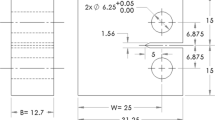Abstract
The geometry of crack faces often plays a critical role in reducing crack extension forces when crack closure occurs during fatigue crack growth. Most previous studies of fatigue crack closure are concerned with mechanical measures of closure as related to the crack growth rate; very little attention has been given to the geometry of the crack surfaces. Our objective is to identify those aspects of crack surface geometry that are important in the closure process, to develop quantitative fractographic techniques to estimate such attributes in a statistically significant and robust manner, and to correlate them to the physical process of crack closure. For this purpose, fatigue crack propagation experiments were performed on a Ni-base superalloy and crack growth rates and crack closure loads were measured. Digital image profilometry and software-based analysis techniques were used for statistically reliable and detailed quantitative characterization of fatigue crack profiles. It is shown that the dimensionless, scale-independent attributes, such as height-to-width ratio of asperities, fractal dimensions, dimensionless roughness parameters,etc., do not represent the aspects of crack geometry that are of primary importance in the crack closure phenomena. Furthermore, it is shown that the scaledependent characteristics, such as average asperity height, do represent the aspects of crack geometry that play an interactive role in the closure process. These observations have implications concerning the validity of geometry-dependent, closure-based models for fatigue crack growth.
Similar content being viewed by others
References
W. Elber:Damage Tolerance in Aircraft Structures, ASTM STP 486, ASTM, Philadelphia, PA, 1971, pp. 230–45.
D. Taylor:Fatigue Thresholds, Butterworth and Co., London, 1989.
T. Lindley and C. Richards:Mater. Sci. Eng., 1974, vol. 14, pp. 281- 93.
B. Budianski and J. Hitchinson:J. Appl. Mech.character., 1981, vol. 45, pp. 267–76.
S. Suresh and R. Ritche:Metall. Trans. A, 1982, vol. 13A, pp. 1627–31.
K. Minakawa and A. McEvily:Scripta Metall, 1981, vol. 15, pp. 633–36.
J. McCarver and R. Ritche:Mater. Sci. Eng., 1982, vol. 55, pp. 63–67.
K. Ravichandran:Int. J. Fract., 1990, vol. 44, pp. 97–110.
S. Suresh and R. Ritche:Eng. Fract. Mech., 1983, vol. 18, pp. 174- 86.
J.L. Yuen and P. Roy:Fatigue Crack Growth Threshold Concepts, D. Davidson and S. Suresh, eds., TMS, Warrendale, PA, 1983, pp. 112–24.
J.K. Shang, J.L. Tzou, and R.O. Ritche:Metall. Trans. A, 1987, vol. 18A, pp. 1613–27.
D. Kreuger, S.D. Antolovich, and R. Van Stone:Metall. Trans. A, 1987, vol. 18A, pp. 1431–49.
E. Zaiken and R. Ritche:Mater. Sci. Eng., 1985, vol. 70, pp. 151–60.
J.E. King:Mater. Sci. Technol, 1987, vol. 3, pp. 750–64.
K. Ravichandran and E. Dwarkadasa:Metall. Trans. A, 1990, vol. 21A, pp. 3171–86.
K. Esasklul, A. Wright, and W. Gerberich:Scripta Metall, 1983, vol. 17, pp. 1073–78.
R. Carter, E. Lee, E. Starke, and C. Beevers:Metall. Trans., 1984, vol. 15A, pp. 555–63.
R. Bowman: Ph.D. Dissertation, Georgia Institute of Technology, Atlanta, GA, 1988.
K. Venkateswara Rao, W. Yu, and R. Ritche:Metall. Trans. A., 1988, vol. 19A, pp. 549–61.
J. Wasen, K. Hamberg, and B. Karlsson:Mater. Sci. Eng., 1988, vol. 102, pp. 217–26.
P. Liaw and W. Logsdon:Acta Metall, 1988, vol. 36, pp. 1731–44.
W. Gerberich, W. Yu, and K. Esasklul:Metall. Trans. A., 1984, vol. 15A, pp. 875–88.
K. Ravichandran, H. Venkata Rao, E. Dwarkadasa, and C. Krishnadas Nair:Metall Trans. A., 1987, vol. 18A, pp. 865–76.
W.J. Drury: Ph.D. Dissertation, Georgia Institute of Technology, Atlanta, GA, 1993.
R. Bowman, S.D. Antolovich, and R. Brown:Eng. Fract. Mech., 1988, vol. 31, pp. 703–12.
M. Bartlett: Master’s Thesis, Georgia Institute of Technology, Atlanta, GA, 1987.
A.M. Gokhale, W.J. Drury, and S. Mishra: inFractography of Modern Engineering Materials--II, L. Gilbertson and J. Masters, eds., ASTM STP 1203, ASTM, Philadelphia, PA, 1993, 1–18.
W.J. Drury and A.M. Gokhale:Metallography: Past, Present, and Future, G.F. Vander Voort, ed., ASTM STP 1094, ASTM, Philadelphia, PA, 1992.
A.M. Gokhale and E.E. Underwood:Metall. Trans. A., 1990, vol. 21 A, pp. 1193–99.
A.M. Gokhale and W.J. Drury:Mater. Characterization, 1993, vol. 31, pp. 115–23.
B.B. Mandelbrot:Fractal Geometry of Nature, W.H. Freeman and Co., New York, NY, 1982.
C.J. Beevers, K. Bell, and R.L. Carlson:Eng. Fract. Mech., 1984, vol. 19, pp. 93–100.
Author information
Authors and Affiliations
Rights and permissions
About this article
Cite this article
Drury, W.J., Gokhale, A.M. & Antolovich, S.D. Effect of crack surface geometry on fatigue crack closure. Metall Mater Trans A 26, 2651–2663 (1995). https://doi.org/10.1007/BF02669422
Received:
Published:
Issue Date:
DOI: https://doi.org/10.1007/BF02669422



